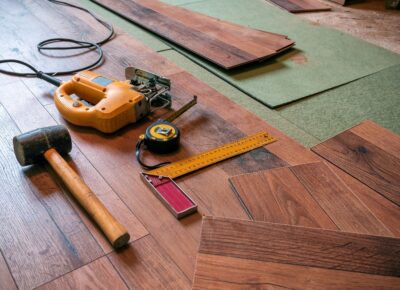In the wake of two major hurricanes passing through the southeast, and the sometimes devastating damage of homes, homeowners could be facing major repairs at the very least. Even as floor replacement people, it’s not something we wish on anyone. Besides calling on professionals when you need to replace or repair a damaged floor, we’re happy to offer advice for anyone taking on the task themselves.
Reasons To Repair or Replace A Floor
The first problem is deciding whether to replace or repair a damaged floor. The decision depends on several factors:
The extent of the damage: Repairs may be sufficient if the damage is limited to minor warping or discoloration. However, if the flooring is significantly warped, or swollen, or moldy, it may require replacement.
The flooring material: Different types of flooring material could factor into your decision. Hardwood flooring can be refinished or repaired if there isn’t severe damage or mold. Laminate flooring doesn’t hold up well to moisture, and should be replaced if waterlogged. Vinyl flooring can often take a simple repair, but you should replace it if the damage is extensive. Finally, if you have tile flooring, the grout may need repair, but you can usually replace individual tiles.
Condition of the subfloor: You should check underneath the flooring and ensure that there is no water damage or mold. Check for structure issues as well. If your subflooring has significant damage, replacement may be necessary with any flooring type.
Flooring Repair Options
If you decide that repairs will be sufficient for your flooring, you need to determine your repair tasks.
If you have minor damage to repair, perform repairs that suit the damage. If you need to dry the floor, use fans and dehumidifiers. For refinishing, you may need to replace planks and sand and refinish the hardwood. For simple cleaning, be sure to use appropriate cleaning fluids and materials.
For more significant damage, you may need to replace sections of laminate or hardwood. For tile flooring, you can re-grout the floors to improve their appearance and prevent moisture buildup.
Flooring Replacement Options
If you have truly extensive flooring damage, you may need to replace the floor entirely. If you live in a flood-prone area, choose water-resistant materials such as luxury vinyl or tile.
Take steps to prevent similar flooring problems in the future, like a vapor barrier to protect from moisture, keeping electrical and HVAC systems above flood levels, and ensuring that your gutters direct water away from your property.
If you’re not sure about how to evaluate the damage or whether to repair or replace your damaged floor, reach out to a professional in the area. At Upstate Flooring Direct, we can assist you with your flooring needs in the Upstate South Carolina region. Contact us today, and we’ll be happy to meet with you.
See more flooring advice, customer stories, and more on our Facebook page!

